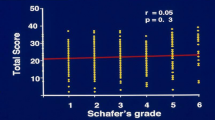Abstract
Purpose
To assess the correlation between urodynamic parameters and urinary tract complications linked to benign prostatic enlargement (BPE), as well to assess the possible value of these parameters for predicting complications.
Methods
We retrospectively analyzed the relationship between the complications and correlative urodynamic data of 486 BPH patients. Multivariate stepwise logistic regression was used to identify major independent predictors and establish regression models. Receiver operating characteristic (ROC) curves were constructed to evaluate the models’ predictive values.
Results
All of the individual parameters examined significantly correlated with most of the complications linked to BPE, except bladder calculus. According to ROC analysis, all of the areas under ROC curves (AUC), comparison of the individual parameters and the combined effects from the logistical regression models reached statistical significance (p < 0.05), and combining the parameters revealed a higher AUC compared to the individual parameters; however, all of the AUCs were below 0.9.
Conclusions
Urodynamic parameters are significantly correlated with most of the complications linked to BPE, and these parameters have predictive value for the occurrence of these complications with limited values.

Similar content being viewed by others
References
Priest R, Garzotto M, Kaufman J (2012) Benign prostatic hyperplasia: a brief overview of pathogenesis, diagnosis, and therapy. Tech Vasc Interv Radiol 15(4):261–264
Bushman W (2009) Etiology, epidemiology, and natural history of benign prostatic hyperplasia. Urol Clin North Am 36(4):403–415
Gray M (2010) Traces: making sense of urodynamics testing–part 2: uroflowmetry. Urol Nurs 30(6):321–326
Oelke M, Kirschner-Hermanns R, Thiruchelvam N, Heesakkers J (2012) Can we identify men who will have complications from benign prostatic obstruction (BPO)? ICI-RS 2011. Neurourol Urodyn 31(3):322–326
Parsons BA, Hashim H (2011) Emerging treatment options for benign prostatic obstruction. Curr Urol Rep 12(4):247–254
Reilly NJ (1994) The release of the clinical practice guideline: benign prostatic hyperplasia: diagnosis and treatment. Urol Nurs 14(2):37
McConnell JD, Roehrborn CG, Bautista OM et al (2003) The long-term effect of doxazosin, finasteride, and combination therapy on the clinical progression of benign prostatic hyperplasia. N Engl J Med 349:2387–2398
Nitti VW (2005) Pressure flow urodynamic studies: the gold standard for diagnosing bladder outlet obstruction. Rev Urol 7(Suppl 6):S14–S21
Abrams P (1999) Bladder outlet obstruction index, bladder contractility index and bladder voiding efficiency: three simple indices to define bladder voiding function. BJU Int 84(1):14–15
Jacobsen SJ, Jacobson DJ, Girman CJ, Roberts RO, Rhodes T, Guess HA, Liebe MM (1997) Natural history of prostatism: risk factors for acute urinary retention. J Urol 158(2):481–487
Crawford ED, Wilson SS, McConnell JD et al (2006) Baseline factors as predictors of clinical progression of benign prostatic hyperplasia in men treated with placebo. J Urol 175(4):1422–1426; discussion 1426–7
Ko YH, Chae JY, Jeong SM, Kang JI, Ahn HJ, Kim HW, Kang SG, Jang HA, Cheon J, Kim JJ, Lee JG (2010) Clinical implications of residual urine in Korean benign prostatic hyperplasia (BPH) patients: a prognostic factor for BPH-related clinical events. Int Neurourol J 14(4):238–244
Millan-Rodriguez F, Errando-Smet C, Rousaud-Baron F et al (2004) Urodynamic findings before and after noninvasive management of bladder calculi. BJU Int 93:1267–1270
Madersbacher S, Alivizatos G, Nordling J et al (2004) EAU 2004 guidelines on assessment, therapy and follow-up of men with lower urinary tract symptoms suggestive of benign prostatic obstruction (BPH guidelines). Eur Urol 46:547–554
Taylor JA 3rd, Kuchel GA (2006) Detrusor underactivity: clinical features and pathogenesis of an under diagnosed geriatric condition. J Am Geriatr Soc 54(12):1920–1932
Guo LJ, Tang Y, Guo CM, Zhang XH (2010) Impact of primary hypertension on hematuria of the patients with benign prostatic hyperplasia. Chin Med J (Engl) 123(9):1154–1157
Hochberg DA, Basillote JB, Armenakas NA, Vasovic L, Shevchuk M, Pareek G, Fracchia JA (2002) Decreased suburethral prostatic microvessel density in finasteride treated prostates: a possible mechanism for reduced bleeding in benign prostatic hyperplasia. J Urol 167(4):1731–1733
Stachon A, Aweimer A, Stachon T, Tannapfel A, Thoms S, Ubrig B, Köller M, Krieg M, Truss MC (2009) Secretion of soluble VEGF receptor 2 by microvascular endothelial cells derived by human benign prostatic hyperplasia. Growth Factors 27(2):71–78
Childs MA, Mynderse LA, Rangel LJ, Wilson TM, Lingeman JE, Krambeck AE (2013) Pathogenesis of bladder calculi in the presence of urinary stasis. J Urol 189(4):1347–1351
Belal M, Abrams P (2006) Noninvasive methods of diagnosing bladder outlet obstruction in men. Part 1: nonurodynamic approach. J Urol 176:22–28
Arnolds ML, Oelke M (2009) Positioning invasive versus noninvasive urodynamics in the assessment of bladder outlet obstruction. Curr Opin Urol 19:55–62
Oelke M (2010) International Consultation on Incontinence-Research Society (ICI-RS) report on non-invasive urodynamics: the need of standardization of ultrasound bladder and detrusor wall thickness measurements to quantify bladder wall hypertrophy. Neurourol Urodyn 29:634–639
Chia SJ, Heng CT, Chan SP et al (2003) Correlation of intravesical prostatic protrusion with bladder outlet obstruction. BJU Int 91:371–374
Miyashita H, Kojima M, Miki T (2002) Ultrasonic measurement of bladder weight as a possible predictor of acute urinary retention in men with lower urinary tract symptoms suggestive of benign prostatic hyperplasia. Ultrasound Med Biol 28:985–990
Acknowledgments
This study was supported by the National Natural Science Foundation of China (Charity no. 81230017, 81170704). The funders had no role in study design, data collection and analysis, decision to publish, or preparation of the report.
Conflict of interest
We certify that there is no actual or potential conflict of interest in relation to this article.
Author information
Authors and Affiliations
Corresponding author
Rights and permissions
About this article
Cite this article
Yang, X., Wang, K., Zhao, J. et al. The value of respective urodynamic parameters for evaluating the occurrence of complications linked to benign prostatic enlargement. Int Urol Nephrol 46, 1761–1768 (2014). https://doi.org/10.1007/s11255-014-0722-1
Received:
Accepted:
Published:
Issue Date:
DOI: https://doi.org/10.1007/s11255-014-0722-1




